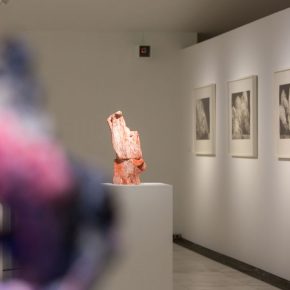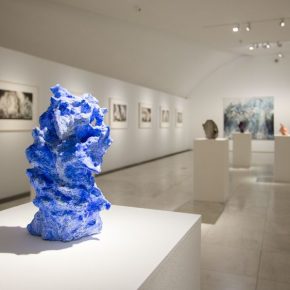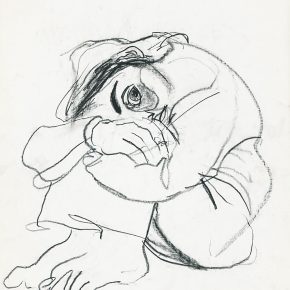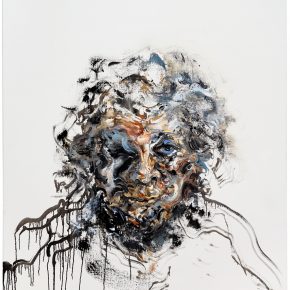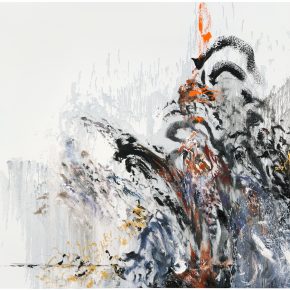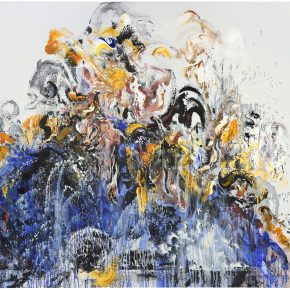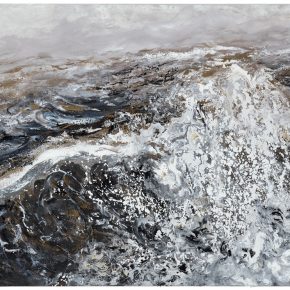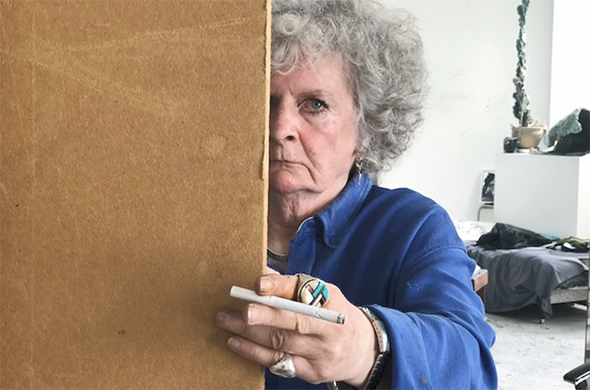
British Vogue conducted an interview with Maggi Hambling about her five most treasured belongings. Cigarettes and whiskey were her first choices as they have helped fuel her inspiration. Then followed by her sculptures and pigments for paintings. Maggi Hambling has sliver curly hair and wears fashion conscious jeans, she seems to never be seen without a cigarette between her fingers and her intense eyes reveal her unique alert insight...This cool female artist makes a vivid impression just like her work which is full of individual expression.
She rejects any art without “love”.
“Would a person whom you do not love become the subject of your painting?”
“I refused the invitation from Ms.Thatcher who was the former British Prime Minister. As I do not feel any love for Ms. Thatcher, but love is the basis of all art creations.”
Maggi Hambling, who is 73-year-old now, gained an international reputation in the 1980s and it has only been enhanced since then with recent shows at major museums such as the Hermitage in St Petersburg, Russia. “FOR BEAUTY IS NOTHING BUT THE BEGINNING OF TERROR” is an exhibition that stretches over her lifelong creations and showcases about 60 Maggi Hambling’s works from the 1960s to the present day, including oil paintings, ink, graphite, charcoal drawings as well as a number of wooden sculptures.
I already know the storm, and I am as troubled as the sea.
I leap out, and fall back,
and throw myself out and am absolutely alone
in the great storm.
Quoted from Vorgefühl by Rainer Maria Rilke (Sense of Something Coming translated by Robert Bly)
Maggi Hambling’s home and studio is in Suffolk, in the East of England, not far from where she was born in 1945. It is the area where the great painter John Constable and the composer Benjamin Britten lived and worked—both figures important to Maggi Hambling. Constable painted clouds with a regularity and intensity that she gives to the sea; and Maggi has paid her homage to the composer in a large sculpture that she made for the beach where Britten walked each day. Although many Chinese visitors might not be familiar with Maggi Hambling, “when we stand in front of her work, we feel impressive as we have seen them in so many important international art museums,” said Zhang Zikang, Director of the CAFA Art Museum. Besides her controversial work The Scallops, the Monument of Oscar Wilde is another masterpiece of her public sculptures.
This exhibition centers on two bodies of work. The first focuses on Maggi Hambling’s extraordinary Wall of Water painting, monotypes and related paintings which have already been exhibited in major Western museums. The second focuses on her portraits of individuals. These include a famous painting of Henrietta Moraes, her lover and Francis Bacon’s muse, as well as tender drawings of her father, alive and dead, teachers and intimate friends.
POEM IN OILS
Carol Ann Duffy
What I have learnt I have learnt from the air,
from infinite varieties of light. Muted colours
alter gradually as clouds stir shape, till purple rain
or violet thunderstorm shudders in the corner of my eye.
Here, on this other coast, the motifs multiply.
I hesitate before the love the waves bear
to the earth. Is this what I see?
No, but this is the process of seeing.
Believe me, soundless shadows fall from trees
like brushstrokes. A painter stands
upon a cliff and turns doubt into certainty where,
far below, the ocean fills itself with sky.
I was here to do this. And was curious.
* Carol Ann Duffy has written many award-winning volumes of poetry and was appointed Britain’ s Poet Laureate by the Queen in 2009.
When Maggi Hambling talked to Carol Ann Duffy about the Wall of Water paintings and the exhibitions in China, the poet offered her this poem.
In Maggi Hambling’s most iconic work, the Walls of Water series, she uses an extraordinary range of brushstrokes, including what looks like abstract gestures as expressions of strong emotions to describe the sea crashing into a wall over and over again. The sound of those big waves crashing seems to penetrate the picture. These paintings are the feelings of the artist in the face of beautiful and terrifying nature as well as having a sexual dimension. “In a period when many artists try to be sexy, and only end up being commercial and competitive, she’s the real thing,” said John Berger, critic and novelist.
Surprisingly, Maggie is not good at swimming at all. She recalled that she went into the sea when she was 3 or 4 years old. She kept talking to the sea although she did not get any response... “Many years have passed, now I paint the sea and I listen; when the sea begins to speak, I become its listener.” This obsession and listening with the sea, is her hidden feeling of fate, her attachment to an object, as well as the way she communicates with herself.
As Philip Dodd, Curator for this exhibition mentioned in his interview with Maggi which was entitled A WORLD IN A GRAIN OF SAND, “The sound of those big waves crashing seems to penetrate the picture. These paintings are the feelings of the artist in the face of the beautiful and terrifying nature, and have a sexual dimension.” Maggi replied that, “Most certainly. A distant wave plays across the surface of the sea from the horizon, rather like foreplay, and then as it hits the land and rises and explodes and crashes—that is pretty orgasmic...At the base of each of the Wall of Water paintings is a vulnerable sea wall, and there are great crashing waves having their revenge on the manmade world. We are fucking up the planet. I wanted the sense that the sea wall could be completely destroyed by the power of nature—pounding and pounding and pounding. The fragility of man compared with nature.”
Water, is one of the key elements of Chinese culture or even Eastern cultures. There are also some drawings the artist created with ink exhibiting at the exhibition. At the British Museum in the late Sixties, she saw Chinese and Japanese paintings and they made a significant impact on her, “the supreme mark making, the economy and the poetry...Yet you’re there – that world is real to you as you look at that scroll. That world has been made tangible in such a simple and eloquent way.” In the Walls of Water series, she uses an extraordinary range of brushstrokes, including what looks like abstract gestures as expressions of strong emotions to describe the sea crashing into a wall over and over again.
The exhibition title “For beauty is nothing but the beginning of terror” is taken from “Duino Elegy”, written by the great Austrian poet Rainer Maria Rilke, which has also been Hambling's touchstone across her whole career. Rilke conveyed the meaning of the infinite and inexpressible significance with finite things, which is similar to Maggi’s affection for beauty, love and the universe.
As for her portrait drawings, Hambling depicts people she deeply loves, including her late father and mother, her lovers and teachers. There are also self-portraits. John Berger has written The 235 Days about Hambling’s 235-day drawings which record her moving passion for her muse and lover Henrietta Moraes (also a muse of artists such as Francis Bacon). She draws over and over again her loved ones, and never stops even after they have passed away. For Hambling, “the basis of any work of art must be love”, a love which is passionate, disturbing, gentle and fragile. Hambling’s paintings are vivid and visceral, from the heart.”
As Charles Saumarez Smith, former Director of National Portrait Gallery, commented, “There are very few people in the world who can convey character as effectively as Maggi can—sad, tender, melancholy drawings of people she loves and admires, including her father, who she drew over and over again on his deathbed, as well as one of her girlfriends, Tory. She looks at people with intensity. It is perhaps not an accident that Lucian Freud was also deeply influenced by Cedric Morris and Arthur Lett-Haines. Maggi Hambling is like Lucian Freud—passionate and bohemian, an outsider, but continuing a long critical tradition of observation, drawing and painting skill, which are important to the world.”
“Brimming with detail yet extremely incisive, such portraits are rarely seen in the contemporary art world. They are introspective, serious, and filled with wisdom and creativity,”said Zhang Zikang, Director of CAFA Art Museum, Beijing.
“Drawing a face is one way of noting down a biography. Good portraits are both prophetic and retrospective...The passage across time is not something consciously sought by the artist; it emerges naturally from the act of drawing,” John Berger wrote in his THE 235 DAYS, “When Maggi Hambling met Henrietta face to face in February 1998 (it was not the first time they had met, but it a decisive meeting), Fate put three cards face down on the table. The first showed Maggi drawing Henrietta day after day until her death. The second foresaw Henrietta asking Maggi to hug her a few seconds before she died. And the third predicted that the two of them would fall in love with one another.”
This outstanding lady has always faced the world in her most authentic state. She was the one who won the applause of audiences as she told the translator at the opening ceremony, it’s unnecessary to explain more and she spoke loudly, “art is the best way for communication in the world, and it has no boundaries as it needs no language or translation.” She is also the one who told us sincerely that painting works for themselves and themes guided her, she worked as a “pure artist” as she said, “I don’t feel at all in charge. The painting paints itself, and those are the moments I live for.” Maggi Hambling weaves all her expressions in “sexy oil paints” and tells her memories, feelings and expectations of life through her creations, “my work is my best attempt at love.”
Text by Zhang Yizhi, edited and translated by Sue/CAFA ART INFO
Photo by Hu Sichen/CAFA ART INFO, Work Image Courtesy of the Artist and Organizer.




